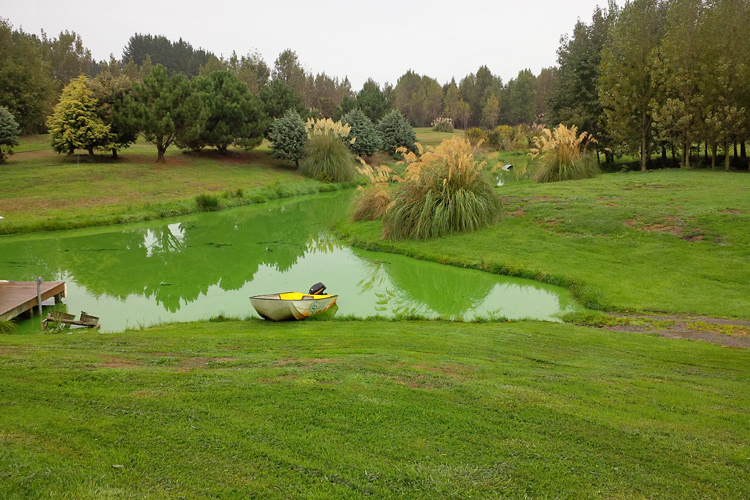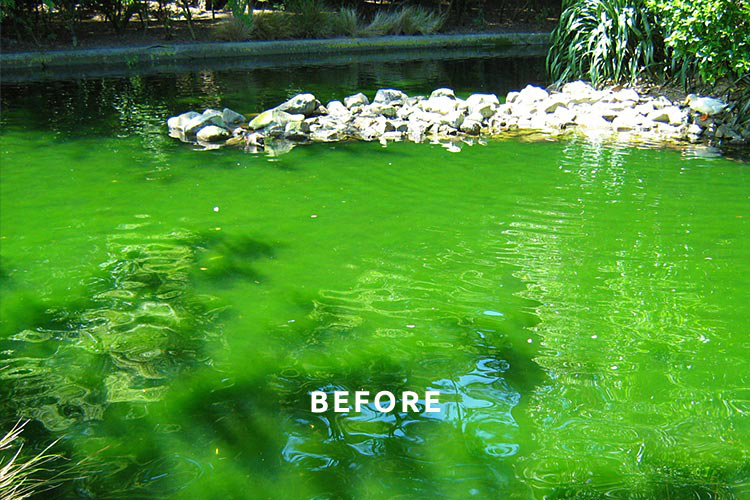Private: Lakes & Ponds
Cyanobacteria – Also Known as Blue-Green Algae
Cyanophyta
Cyanobacteria, also called blue-green algae, are microscopic organisms found naturally in all types of water. These single-celled organisms live in fresh, brackish (combined salt and fresh water), and marine water. These organisms use sunlight to make their own food.
Cyanobacteria blooms can start to multiply very quickly. Blooms can form in warm, slow-moving waters that are rich in nutrients from sources such as fertiliser runoff or septic tank overflows. Cyanobacteria blooms need nutrients to survive. Blooms can form at any time, but most often form in late summer or early Autumn.
How can you identify it?
You might or might not be able to see cyanobacteria blooms. They sometimes stay below the water’s surface, and sometimes float to the surface. Some cyanobacteria blooms can look like foam, scum, or mats, particularly when the wind blows them toward a shoreline. The blooms can be blue, bright green, brown, or red. Blooms sometimes look like paint floating on the water’s surface. As cyanobacteria in a bloom die, the water may smell bad, similar to rotting plants.
Every lake is different, find out what program works best for you.
Check your pond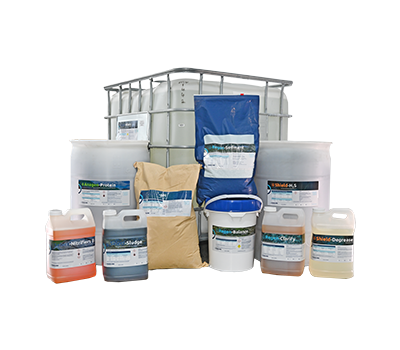
Did you know?
Cyanobacterial blooms are a significant public health issue, particularly in summer Cyanobacteria (blue-green algae) produce a variety of toxins such as hepatotoxins, neurotoxins and dermatoxins which are detrimental to human and animal health.
Products
Industry Leading Solutions
REGEN-CyaNo®
REGEN-CyaNo®
Use REGEN-CyaNo® to control Cyanobacteria. REGEN-CyaNo® is a granular algaecide that can be used to spot-treat targeted areas.
Approved for the selective control of cyanobacteria in lakes, ponds, potable water, aquaculture and wastewater, REGEN-CyaNo® active ingredient creates a powerful oxidation reaction that destroys algal cell membranes and chlorophyll, providing immediate algae control.
REGEN-CyaNo® is the ideal choice to keep your lakes, fishing and farm ponds, aquaculture sites, and other private water bodies pleasing to the eye and safe.
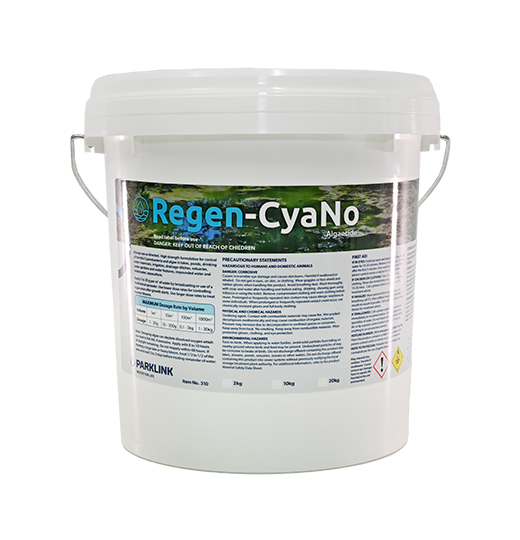
Science Behind It
Many water bodies are threatened by excessive nutrients entering through lawn and garden run-off, construction sites, wastewater discharges, detergent wastes, septic tank seepage and agricultural run-off. Excessive nutrients support the dynamic growth of cyanobacteria (blue-green algae) and other aquatic algae, interfering with intended water uses and sometimes presenting health hazards to humans and animals. REGEN-CyaNo® is the choice to keep your lakes, fishing and farm ponds, sites and other private water bodies, safe for your enjoyment. REGEN-CyaNo® creates a powerful oxidation reaction that destroys algal cell membranes and chlorophyll, providing immediate control of algae. For best results apply early when algae growth first appears.
Description and Benefits
Professional Strength Oxidizer is a highly effective Algaecide, Fungicide, and Bactericide
Effective on a wide variety of algae, and Cyanobacteria
– Immediate algae control and reduced toxicity
– More effective than copper sulphate
– No run-off concerns
– Can be used in irrigation canals and reservoirs
– Proven safe for all crops
– A great alternative to copper-based products.
Dose Rates
Irrigation water/Surface water
Cyanobacteria or commonly known as (Blue Green Algae): 1 – 30g per m³ – broadcast granules over the entire volume of water.
Spot Treatment: Apply REGEN-CyaNo® directly over the cyanobacteria-covered area. Retreat with heavy growth.
See Product Label and Safety Data Sheet for all usage directions. Use only as directed.
Dosage
MAXIMUM Dosage Rate by Volume
| Volume | 1m3 | 10m3 | 100m3 | 1000m3 |
| Dosage | 1 - 30g | 10 - 300g | 0.1 - 3kg | 1 - 30kg |
Downloads
REGEN-Alguard
REGEN-Alguard
REGEN-Alguard® is a commercial-grade liquid chelated copper-based algaecide, used for the safe, rapid and effective control of a broad spectrum of filamentous and planktonic algae. REGEN-Alguard® is up to 80% less copper than current (copper-based) algaecides and is widely used to control algae in lakes, irrigation dams, decorative ponds and more. REGEN-Alguard® will not harm fish, livestock, plants, pastures or turf (when used in accordance with label instructions).
REGEN-Alguard® works by weakening cyanobacteria and algae cells. Copper ions stop photosynthesis causing the cells to die and dissolve into the water. There is minimal harm to organisms in the water. Residual toxins are rapidly biodegraded. REGEN-Alguard® rapidly disperses throughout the water body without settling to the bottom or floating on top like other copper-based algaecides.

How to Use
Apply in a manner that will ensure even product distribution within the treatment area. Retreat areas if regrowth begins to appear or if seasonal control is desired. Repeating application of this product too soon after initial application may have no effect. Treatment of aquatic weeds and algae can result in oxygen loss from the decomposition of dead biomass. This oxygen loss can cause fish and invertebrate suffocation. To minimize this hazard, do not treat more than ½ of the water body and wait at least 14 days between treatments to avoid depletion of oxygen. Begin treatment along the shore and proceed outwards in bands to allow fish to move into untreated areas. Application of algaecides to high-density blooms of cyanobacteria can result in the release of intracellular contents into the water. Some of these intracellular compounds are known mammalian hepato- and nervous system toxins. Therefore, to minimize the risk of toxin leakage, manage cyanobacteria effectively in order to avoid applying this product when blooms of toxin-producing cyanobacteria are present at high density. Certain water conditions including low pH (≤6.5), low dissolved organic carbon (DOC) levels (3.0 mg/L or lower) and “soft” waters (i.e. alkalinity less than 50 mg/L) increases the potential acute toxicity to non-target aquatic organisms. The application rates on the label are appropriate for water with pH values > 6.5, DOC levels >3.0 mg/L, and alkalinity greater than 50 mg/L. Avoid treating waters with pH values <6.5, DOC levels <3.0 and alkalinity less than 50ppm (e.g., soft or acid water), as koi, trout and other sensitive species of fish may be killed under such conditions.
Dosage
MAXIMUM Dosage Rate by Volume
| Volume | 10m³ | 100m³ | 1,000m³ |
| Dosage | 20 - 90 mL | 0.2 - 0.9 L | 1.8 - 9.2 L |
Downloads
REGEN-Alguard Plus
REGEN-Alguard Plus
REGEN-Alguard Plus® contains dual biocidal activity for instantaneous and prolonged control of algae.
REGEN-Alguard Plus® is a commercial-grade liquid chelated copper-based algaecide, used for the safe, rapid and effective control of a broad spectrum of filamentous and planktonic algae. REGEN-Alguard® is up to 80% less copper than current (copper-based) algaecides and is widely used to control algae in lakes, irrigation dams, decorative ponds and more. REGEN-Alguard® will not harm fish, livestock, plants, pastures or turf (when used in accordance with label instructions).
REGEN-Alguard® works by weakening cyanobacteria and algae cells. Copper ions stop photosynthesis causing the cells to die and dissolve into the water. There is minimal harm to organisms in the water. Residual toxins are rapidly biodegraded. REGEN-Alguard® rapidly disperses throughout the water body without settling to the bottom or floating on top like other copper-based algaecides.
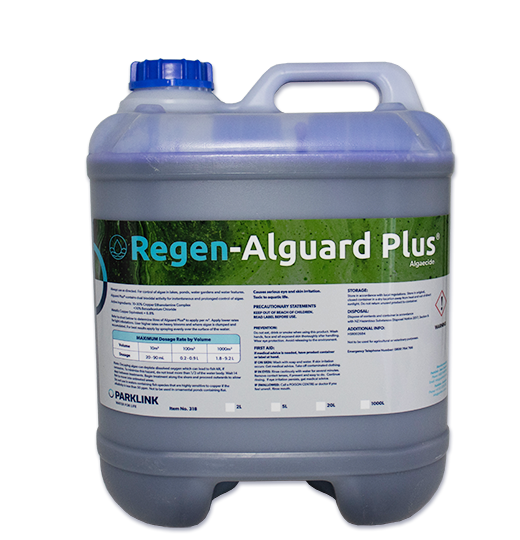
How to Use
Apply in a manner that will ensure even product distribution within the treatment area. Retreat areas if regrowth begins to appear or if seasonal control is desired. Repeating application of this product too soon after initial application may have no effect. Treatment of aquatic weeds and algae can result in oxygen loss from the decomposition of dead biomass. This oxygen loss can cause fish and invertebrate suffocation. To minimize this hazard, do not treat more than ½ of the water body and wait at least 14 days between treatments to avoid depletion of oxygen. Begin treatment along the shore and proceed outwards in bands to allow fish to move into untreated areas. Application of algaecides to high-density blooms of cyanobacteria can result in the release of intracellular contents into the water. Some of these intracellular compounds are known mammalian hepato- and nervous system toxins. Therefore, to minimize the risk of toxin leakage, manage cyanobacteria effectively in order to avoid applying this product when blooms of toxin-producing cyanobacteria are present at high density. Certain water conditions including low pH (≤6.5), low dissolved organic carbon (DOC) levels (3.0 mg/L or lower) and “soft” waters (i.e. alkalinity less than 50 mg/L) increases the potential acute toxicity to non-target aquatic organisms. The application rates on the label are appropriate for water with pH values > 6.5, DOC levels >3.0 mg/L, and alkalinity greater than 50 mg/L. Avoid treating waters with pH values <6.5, DOC levels <3.0 and alkalinity less than 50ppm (e.g., soft or acid water), as koi, trout and other sensitive species of fish may be killed under such conditions.
Dosage
MAXIMUM Dosage Rate by Volume
| Volume | 10m³ | 100m³ | 1,000m³ |
| Dosage | 20 - 90 mL | 0.2 - 0.9 L | 1.8 - 9.2 L |
Downloads
Phoslock®
Phoslock®
Phoslock® is a unique water treatment product that permanently binds phosphorus in water bodies
What is Phoslock®?
Phoslock® is a product designed for phosphate removal from water. Its active component is lanthanum which reacts with phosphate forming an insoluble and biologically inert compound. Its ability to bind phosphate makes it an effective tool in lake restoration.
Phoslock® was developed in Australia by the CSIRO as a way of utilising the ability of lanthanum to bind phosphate but at the same time making it safe for use in natural aquatic systems.
When used in lake restoration, Phoslock® is usually added to the lake as a slurry. As this sinks through the water column it binds phosphate as it goes. Once settled on the sediment it can continue to bind phosphate released from the sediment, thus controlling one of the major blocks to lake restoration – sediment phosphorus release.
The ability of Phoslock® to bind phosphate is important because phosphate is the form of phosphorus which is biologically available and used by plants – especially algae in lakes, to promote growth. Excessive amounts of phosphate entering water courses is one of the main causes of deterioration of water quality in freshwaters today because of the way it drives algal productivity and undesireable changes in the balance of aquatic life. The process is known as eutrophication. The ability to remove biologically available phosphorus in a lake is therefore a major step towards improving water quality.
Phoslock® can be used in lakes and ponds as well as other standing waters (e.g. reservoirs, fish hatcheries) where high phosphate levels are causing problems. It is not usually applied to flowing waters.
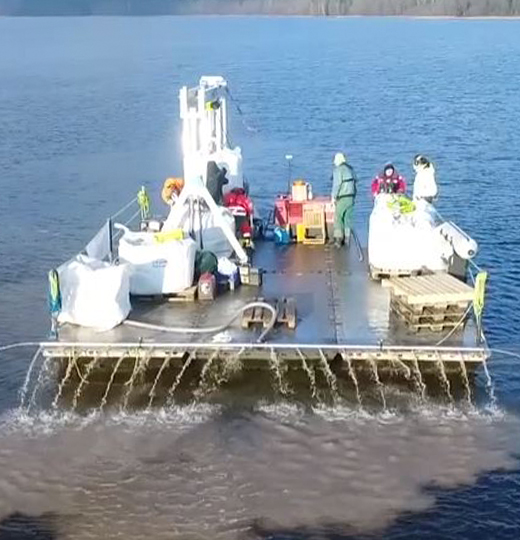
The Science Behind It
Phoslock – technical information
Phoslock is comprised of 95% bentonite and 5% lanthanum. It is manufactured through a controlled ion-exchange process whereby cations within the bentonite are exchanged with lanthanum cations. The result is that lanthanum held within the bentonite structure retains its ability to bind phosphate, but does not readily dissociate, i.e. will not form free ions in water.Phoslock is manufactured as a dry granule which makes it easy to transport and store. It is usually applied as a slurry, being mixed first with some in situ water before being spread across the surface of the water body being treated.
How does Phoslock Work?
Phoslock works by utilizing the ability of lanthanum to react with phosphate. Removal of phosphate by lanthanum is highly efficient and has a molar ratio of 1:1 which means that one ion of lanthanum will bind with one ion of phosphate as follows;
La3+ + PO43- => LaPO4
The product of the reaction is lanthanum phosphate (LaPO4). The important point is that lanthanum phosphate is highly insoluble which means it won’t dissolve, which in turn means it is not biologically available. This is the process by which phosphate (which is dissolved and therefore biologically available) is rendered non-biologically available.Lanthanum phosphate is analogous to a highly insoluble, naturally occurring mineral known as Rhabdophane. Lanthanum is also present in the sediments of many lakes, with typical background concentrations of around 40 mg/kg dry weight.
How does Phoslock work within a water body?
Phoslock granules are generally mixed with in situ water and applied to a water body as a slurry. This has the effect of creating many tiny particles of Phoslock which sink slowly through the water column. As the slurry settles, phosphate in the water column binds to lanthanum contained within the Phoslock, stripping most of the phosphate from the water column. Once settled on the sediment it forms a very thin layer, usually less than 1 mm thick. There it will continue to bind phosphate coming out of the sediment, until the lanthanum binding sites are saturated, at which point no further binding will take place.
Once on the sediment, Phoslock, and the lanthanum phosphate within it, remain as in inert mineral component of the sediment. The nature of the bond between lanthanum and phosphate is such that it will not be broken under a pH range wider than found in almost any natural lake (pH 4-11). Even more importantly, the bond will not be broken under anoxic (low redox potential) conditions, which are prevelant in most lake sediments and many overlying waters. Most other phosphorus binders, especially those containing iron, will release phosphate under anoxic conditions.
How much phosphate does Phoslock remove?
One tonne of Phoslock is capable of removing 34 kg of phosphate (PO4) or 11 kg of phosphorus (P). With this information and a knowledge of the amount of biologically available phosphorus in the water and surface sediments of a lake, it is possible to fairly accurately calculate the Phoslock dose for a waterbody.
Phoslock and algal growth
algal bloomPhosphate is an important food source of algae (particularly blue green algae). By removing phosphate from the water column and preventing its release from sediments, Phoslock essentially deprives algae of an important food source and the proliferation of algae, particularly blue green algae, is reduced.
Both nitrogen and phosphorus are important nutrients for algal growth, however the growth of blue green algae is generally not limited by the concentration of nitrogen as many species of blue green algae can fix and store nitrogen from the atmosphere. The proliferation of blue green algae in a water body is related to the competitive advantage they have over other phytoplankton groups (such as diatoms and green algae) when excess phosphorus is available in the water.
The reduction of phosphate levels in a water body and its sediments through an application of Phoslock will therefore result in a significant reduction of blue green algae and the restoration of healthy ecological conditions which favour the growth of diatoms, green algae and macrophytes.
Benefits of Phoslock
Phoslock offers a wide range of benefits over other methods of reducing phosphorus concentrations in lakes and reservoirs. The combination of these benefits makes Phoslock a unique and innovative solution to eutrophication control.
Some of the most important benefits of Phoslock include:
Reduction of phosphate
The ability of Phoslock to reduce phosphate to levels close to or below standard detection limits (< 10 µg/L) has been well demonstrated in a large number of both laboratory and field applications. Importantly, dosages can also adjusted to achieve phosphorus concentrations that fall within a particular target range (e.g. 20-30 µg/L). This approach is used when it is necessary to reduce phosphorus concentrations to levels that are sufficiently low to prevent blooms of blue green algae but high enough to ensure that the natural level of productivity in the system is retained.
Rapid uptake of phosphate
The kinetic uptake of phosphate by Phoslock varies to some degree according to water chemistry, however in most situations, more than 90% of available phosphate is bound within three hours of an application of Phoslock.
Eco-toxicological safety
mayflyMany eco-toxicity tests have been undertaken on a wide range of test species by a variety of independent academic and governmental research institutions over the past ten years. Collectively, these reports demonstrate that Phoslock has a very low toxicity and is safe to use in all naturally occurring environmental conditions at the recommended dosages. A detailed overview of these studies has been produced by Phoslock Water Solutions’ Technical Team and can be downloaded from the Eco-Toxicity Assessment page.
In addition, unlike other methods of binding phosphate (such as iron and aluminium salts), an application of Phoslock will have no effect on either the pH or the conductivity of the water body.
Stability under varying conditions
Unlike other methods that could be used to immobilize phosphorus in water and sediments, Phoslock is insensitive to the range of redox, temperature and pH conditions that are naturally found in lakes and reservoirs. Furthermore, buffering is not required prior to an application.
Resistance to resuspension
lake in finland with pierSeveral studies have been conducted to determine the resistance of a Phoslock sediment capping to resuspension at different flow velocities. All studies have shown that Phoslock has substantially higher resistance to resuspension than aluminium or iron salts, which can also be used to immobilize phosphorus in sediments. This is not surprising given that the density of Phoslock is much higher than flocculants and highlights the suitability of Phoslock for use, even in shallow lakes.
Long term effect
Following the application of Phoslock to a water body, any phosphate that has reacted with the lanthanum in the clay will remain permanently bound. Furthermore, any lanthanum sites in the clay matrix that have not reacted with phosphate remain active and will continue to bind phosphate (from both external and internal sources) until saturated. This means that an application of Phoslock can be designed to achieve a sustained reduction in phosphate levels.
Case Studies
LAKE OKAREKA, NEW ZEALAND
Lake Okareka is a 330 ha lake on the North Island of New Zealand located in a rich dairying region. Between August 2005 and March 2007, three separate applications of Phoslock totalling 60 tonnes were undertaken by Environmental Bay of Plenty, the regional environment authority in an effort to remove 0.1 tonnes of phosphorus from the lake per year for three years. The applications were undertaken over a surface area of 170 hectares, encompassing the deeper basin of the lake approximately within the 20m contour.
This action was considered necessary by the Lake Okareka Working Party as part of the Lake Okareka Action Plan as the lake was showing increasing evidence of depleted oxygen levels in the bottom water towards the end of summer and nutrients were being released from sediments. Hypolimnetic discharge was initially considered, however this was discounted due to its cost.
Comprehensive monitoring of the lake before and after the Phoslock treatments has shown that the Phoslock addition has reduced the release of phosphorus from the bottom sediments by the targeted 100 kg / year. An additional benefit of the applications has been a decrease in the rate of de-oxygenation of the bottom waters. No adverse effects of the treatment have been noted in the lake chemistry or fish and koura health.
CANNING AND VASSE RIVERS, AUSTRALIA
The applications of Phoslock on impounded sections of the Canning and Vasse Rivers in 2000 / 2001 by the Western Australian Water and Rivers Commission, the Swan River Trust and CSIRO Land and Water were the first full scale applications of Phoslock and were undertaken as trials during the development of Phoslock to determine whether the application of Phoslock could significantly reduce the bio-availability of phosphorus in the water column and sediments of these rivers.
The Canning River application involved the application of 40 tonnes of Phoslock to an 800m section of the river in January 2000, while the Vasse River was treated within an initial application of 20 tonnes of Phoslock on a 650m section during October 2001, followed by two subsequent applications of 10 tonnes each in December 2001 and January 2002.
The applications resulted in reductions in phosphorus concentrations in the water column to below detection limits and substantial reductions in phosphorus efflux from sediments during the course of the trials. A reduction in phytoplankton growth was also clearly evident in the phytoplankton dominated Vasse River. The results from the applications are contained in the downloadable documents presented on this page.
An additional application of 50 tonnes of Phoslock on the Canning River was undertaken by the Western Australian State Government in February 2010.
TORRENS LAKE, AUSTRALIA
Torrens Lake is an impounded section of the Torrens River, a meandering river running through the centre of the city of Adelaide in the Australian State of South Australia. The lake was treated with 50 tonnes of Phoslock in March 2007 and a further 12 tonnes of Phoslock in February 2008. The purpose of the treatments was to reduce the potential for the development of blue green algal blooms that might have threatened scheduled events of the “Adelaide Festival”, a major festival held in the city during February and March. Blue green algal blooms had resulted in the closure of the lake to recreational use in seven of the ten years prior to the Phoslock application.
The results from the 2007 application indicate that Phoslock appeared to have significantly altered the nutrient availability within Torrens Lake, with Phoslock having created and retained a barrier at or near the sediment water interface in four out of the six tested sites seven months after the treatment.
The 2008 Phoslock application provided evidence of a decrease in total algal biomass and cyanobacterial abundance in the water column soon after application. Sediment analysis suggests that the Phoslock treatment reduced the release of bio-available phosphorus, however a redistribution of lanthanum within the lake also occurred after the treatment, possibly due to scouring and drift. As the lake forms part of a river system, applications of Phoslock at critical times in each summer may be required for effective results. No adverse effects of the application on aquatic fauna were measured after either application.
Application
Once the pre-treatment assessment is completed and a decision to proceed to an application has been made, preparations for the treatment can begin.
Application systems
Most applications of Phoslock consist of a venturi mixing system mounted on a motorized barge that is fed with material from a hopper.
Lake water is pumped into the system to allow continuous mixing and the resulting slurry is dispersed onto the lake from a spray boom mounted on the back of the barge. A GPS system is also installed to ensure that the slurry is applied evenly and to the correct location.
Large scale projects involving the application of more than one hundred tonnes of Phoslock are undertaken using product in one tonne bulk bags. Up to ten tonnes of material can be placed on the barge at one time and these bags are lifted by a small on board crane. Up to 50 tonnes of material can be applied to a lake per day using these large systems, with even higher daily application rate.
For small scale applications, a variety of simple systems are available in which product is mixed into a slurry and sprayed onto the surface of the water body from the shore.
Application strategies
Application strategies can be tailored to the particular characteristics of the water body. GPS and depth detection systems are used at all times and it is therefore possible to apply higher dosages of Phoslock to areas of a water body where concentrations of phosphorus in the water or sediment are known to be particularly high.
It is also possible to apply Phoslock either directly onto the surface of the water body or directly into the hypolimnion, or deeper water. The latter approach may be taken when most of the phosphorus in a water body is either in the sediment or the hypolimnion.
Post-treatment monitoring
Following an application, a comprehensive monitoring program is implemented to confirm that the outcome of the application is consistent with the pre-treatment prognosis.
Post-treatment monitoring generally includes measurement of the same parameters that have been measured during the pre-treatment assessment of the water body. These include chemical parameters such as total and soluble nutrients, metals and carbon as well as biological indicators such as chlorophyll a. A variety of on-site measurements are also taken, including dissolved oxygen, pH, redox, temperature and conductivity.
Samples are collected regularly during the 12 months following the application so that a complete picture of the limnological development of the lake can be obtained. Depending on the size and the depth of the lake, samples are also collected from multiple locations and multiple depths.
Sediment samples are also collected on at least one occasion following the treatment so that changes that have occurred in sediment composition as a result of the application can be measured.
Following the conclusion of the post-treatment monitoring program, treatment reports are generally prepared and submitted to the water body owner (and water authorities if required).
Videos
FAQ
What is Phoslock?
Phoslock was developed in Australia by the Commonwealth Scientific and Industrial Research Organisation (CSIRO), to remove phosphates from water. The active element in Phoslock is lanthanum (a rare-earth element) which has a strong affinity to bind with phosphate. This forms an insoluble and biologically inert compound, Rhabdophane. Phoslock is comprised of 95% bentonite and 5% lanthanum.
What is Phoslock made from?
It is manufactured through a controlled ion-exchange process whereby cations within the bentonite are exchanged with lanthanum cations. The result is that lanthanum held within the bentonite structure retains its ability to bind phosphate, but does not readily dissociate, i.e. will not form free ions in water.
Phoslock is manufactured as a dry granule which makes it easy to transport and store.
How does Phoslock work?
Phoslock works by utilizing the ability of lanthanum to react with phosphate. Removal of phosphate by lanthanum is highly efficient and has a molar ratio of 1:1 which means that one ion of lanthanum will bind with one ion of phosphate. This binding forms the mineral Rhabdophane (an insoluble and biologically inert compound) which strips phosphate from the water.
How quickly is phosphate removed after a Phoslock application?
The kinetic uptake of phosphate by Phoslock varies to some degree according to water chemistry, however in most situations, more than 90% of available phosphate is bound within three hours of an application of Phoslock.
Is Phoslock environmentally safe?
Phoslock has been applied to a wide range of waterbodies. Some applications have occurred to drinking waters, while others have occurred on waterbodies with high conservation importance. Many applications have also occurred on lakes which are used for recreational water sports e.g. swimming, but frequently need to be closed due to outbreaks of blue-green algae.
Many eco-toxicity tests have been undertaken on a wide range of test species by a variety of independent and governmental research institutions over the last few decades. Collectively, these reports demonstrate that Phoslock is safe to use in all naturally occurring environmental conditions at the recommended dosages.
How much phosphorus does Phoslock remove?
One tonne of Phoslock is capable of removing 34 kg of phosphate (PO4) or 11 kg of phosphorus (P).
With this information and a knowledge of the amount of biologically available phosphorus in the water and surface sediments of a lake, it is possible to accurately calculate the Phoslock dose for a water body.
What are the benefits of using Phoslock?
Phoslock offers a wide range of benefits over other methods for reducing phosphorus concentrations in waterbodies. Some of the most important benefits include:
Reduction of phosphate | The ability of Phoslock to reduce phosphate to levels close to or below standard detection limits (< 10 µg/L) has been well demonstrated in a large number of both laboratory and field applications. Importantly, dosages can also be adjusted to achieve phosphorus concentrations that fall within a particular target range (e.g. 20-30 µg/L). This approach is used when it is necessary to reduce phosphorus concentrations to levels that are sufficiently low to prevent blooms of blue green algae but high enough to ensure that the natural level of productivity in the system is retained.
Rapid uptake of phosphate | The kinetic uptake of phosphate by Phoslock varies to some degree according to water chemistry, however in most situations, more than 90% of available phosphate is bound within three hours of an application of Phoslock.
Eco-toxicity safety | See FAQ above
Stability under varying conditions | Unlike other methods that could be used to immobilize phosphorus in water and sediments, Phoslock is insensitive to the range of redox, temperature and pH conditions that are naturally found in lakes and reservoirs. Furthermore, buffering is not required prior to an application.
Resistance to resuspension | Several studies have been conducted to determine the resistance of a Phoslock sediment capping to resuspension at different flow velocities. All studies have shown that Phoslock has substantially higher resistance to resuspension than aluminium or iron salts, which can also be used to immobilize phosphorus in sediments. This is not surprising given that the density of Phoslock is much higher than flocculants and highlights the suitability of Phoslock for use, even in shallow lakes.
Long-term effects | Following the application of Phoslock to a water body, any phosphate that has reacted with the lanthanum in the clay will remain permanently bound. Furthermore, any lanthanum sites in the clay matrix that have not reacted with phosphate remain active and will continue to bind phosphate (from both external and internal sources) until saturated. This means that an application of Phoslock can be designed to achieve a sustained reduction in phosphate levels. The combination of these benefits makes Phoslock a unique and innovative solution to eutrophication control.
How is Phoslock applied to a water body?
When used in lake restoration, Phoslock is usually added to a water body as a slurry. Phoslock is mixed with in-situ lake water and sprayed over the water’s surface.
As Phoslock sinks, it strips phosphate from the water column. Once settled on the sediment, Phoslock continues to bind phosphate released from the sediment, until the lanthanum binding sites are saturated, at which point no further binding will take place.
When is the best time of year to apply Phoslock?
The best time to apply Phoslock is between late Autumn and early Spring in Europe. This is because during these periods the majority of the available phosphate is not bound in biomass such as algae or aquatic plants but mainly in the sediment.
An application of Phoslock strips the water column of phosphate and then ‘caps’ the bed sediments, and this targets much of the phosphate in the system.
How much Phoslock will be applied to my water body?
Every water body is unique and a water body-specific Phoslock dose would need to be calculated for each potential treatment but typically, 2 – 4 tonnes/hectare of Phoslock are applied but this can vary considerably for individual waterbodies as dosage is based on how much phosphate is in the water column, bound in the sediments and any external sources of phosphorus still entering the waterbody.
How much does it cost?
The cost of an application will vary considerably for a waterbody depending on the location, size, depth and amount of phosphate that would need to be bound to Phoslock.
As the cost varies considerably from waterbody to waterbody, it is necessary to have a certain amount of information available to create an estimated cost.
If you are interested in applying Phoslock to your waterbody, please get in touch and we would be happy to provide an estimated quote.
What information is needed to assess if Phoslock could work at my water body?
Every lake is different and a range of information about the lake needs to be collected when considering a Phoslock treatment. For instance, it is important to determine the sources of excess nutrients to your water body; i.e. are the nutrients coming largely from internal sources (e.g. from phosphorus release from sediments) or from external sources (e.g. from diffuse or point sources in the catchment). This is critical to know as continued high external loads could impact the effectiveness of a Phoslock application.
Water quality data is vital to understand each water body’s unique story. Long-term water quality monitoring data is unfortunately rare for many water bodies but regular monitoring helps us understand what management options may be best if nutrient pollution and symptoms of eutrophication have become a problem, e.g. regular occurrences of algal blooms. Water quality monitoring data is also vital to help us understand if Phoslock is a suitable product to control nutrient pollution in a water body as there are many aspects that need to be considered before an application.
In addition to water quality sampling, sediment sampling is often needed to estimate how much phosphorus is potentially releasable under normal lake conditions. This information, along with other nutrient calculations is used to make an informed dose calculation for a Phoslock application.
Please get in touch if you are considering Phoslock to treat your water body or if you need further information
We can offer advice and create a pre-treatment assessment, estimated dose calculations and costings for your water body.
How long does Phoslock last for?
Phoslock will continue to bind phosphorus until all lanthanum binding sites are saturated. Although the bond formed by lanthanum and phosphate is permanent and will not be broken under naturally occurring conditions in water bodies, the effects of a Phoslock application will depend on if any high external nutrient loads are entering the waterbody.
If high loads are entering a water body following a Phoslock application, then repeated, usually smaller Phoslock doses, may need to be applied.
Sometimes the presence of benthic feeding fish in high densities can impact a Phoslock application through continued sediment disturbance and potentially releasing phosphorus deeper than the Phoslock layer. High biomass of water birds at a water body can also have an impact of Phoslock efficiency through continued high nutrient concentrations after an application.
What is Bentonite?
Bentonite is a clay consisting of smectite minerals, the most common of which is usually montmorillonite.
Bentonite is characterised by exchangeable sodium, calcium or magnesium cations which greatly influence the properties and commercial uses of the clay. Bentonite is often called the mineral of 1000 uses due to its wide range of applications. The major worldwide applications of bentonite are as an additive in foundry sands and drilling muds, as cat litter, as an additive to stock feed to aid digestion, as a binder in iron, as pelletisation processes and as a clarifying agent in wine making and edible oil refining. Bentonite is also commonly used in the paper industry and as an efficient material to line a seal dams and landfill sites.
What is Lanthanum?
Lanthanum is a rare earth element that occurs naturally in the environment in low concentrations.
Lanthanum forms a very strong bond with oxidized anions, such as phosphates, carbonates and silicates, forming lanthanum salts. The bond between lanthanum and ortho-phosphate (LaPO4) is particularly strong and stable under many environmental conditions.
REGEN-Balance®
REGEN-Balance®
Promotes balanced ecosystem after chemical treatment
REGEN-Balance® is a Temperature Driven Solution that excels between 14°C-26°C. This dry probiotic formula is enhanced with psychrophilic, neutrophilic, and mesophilic microorganisms and select stimulants to ensure optimal performance. REGEN-Balance® will quickly cycle out excess nitrogen and phosphorus compounds in aquatic environments. Made for aquatic professionals, it promotes a balanced aquatic ecosystem and rapid recovery from both adverse environmental impacts and chemical treatments.
REGEN-Balance® excels when used alone and can be applied as a dry powder or dissolved and sprayed over the surface of the water. For an extra boost, use REGEN-Balance® in combination with REGEN-Enhancer®
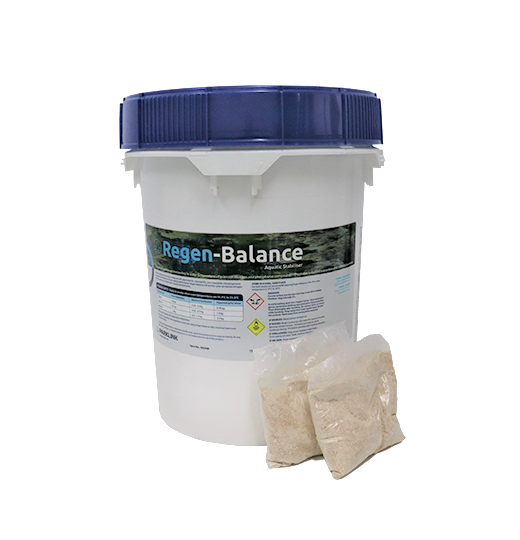
The Science Behind It
Water bodies have stress from both external and internal sources. Excessive rains or draught combined with the ongoing use of algaecides and herbicides deplete the microbial communities that are fundamental to nutrient removal in water bodies. This imbalance in the ecosystem leads to elevated nutrient issues and can result in excessive aquatic plant growth, continuing algal blooms, and HAB’s (Harmful Algal Blooms).
REGEN-Balance® was formulated through years of research by obtaining samples from lakes and ponds across the Globe when water temperatures were mild. The natural microbial communities in the samples were analyzed to understand population densities and the specific organisms that are depleted by stresses. This research is how Parklink was able to create a probiotic that supplements natural populations and supports indigenous organisms that are functional and native to that geography. REGEN-Balance® is more than simple additions of beneficial bacteria. It is a scientifically formulated probiotic that works in harmony with the microbial communities that play key roles in nitrogen and phosphorus uptake. Real science. Real Results.
Specifications
Common Uses
- Lakes and ponds
- Aquaculture
- Hatcheries
- Water features
- Golf courses
- Retention ponds
- Decorative Ponds
- And more!
Benefits
- Consumes nutrients
- Balances Ponds
- Lowers ammonia
- Clarifies water
- Reduces sludge
Available Sizes
- 13.6 kg pail
| Ingredients | Micronutrients and select bacterial cultures |
| Description | Dry tan powder |
| Odor | Earthy odor |
| pH | 7.0 |
| Stability – Activity loss | At 24°C for 12 months*: 10% or less; At 38°C for 6 months*: 10% or less; *When stored as directed in a sealed container out of direct sunlight. |
| Storage and Handling | Store in a cool, dry space between 10 - 27°C. Keep out of direct sunlight and do not store with strong oxidizing agents. |
Dosage
Once per month or as needed.
*Do not mix directly with algaecides or herbicides.
**If used in conjunction with algaecide or herbicide, apply after chemical treatment for best results.
| Surface Area (m²) | Initial Application | Standard Application | Hypereutrophic Water |
| 1,000 | 900 g | 450 - 900 g | 1.4 kg |
| 2,000 | 1.4 kg | 0.5 - 1.4 kg | 2.7 kg |
| 4,000 | 2.7 kg | 1 - 2.7 kg | 5.4 kg |
| 20,000 | 14 kg | 4.6 - 14 kg | 27 kg |
| 40,000 | 27 kg | 9 -27 kg | 54 kg |
| 400,000 | 270 kg | 90 - 270 kg | 540 kg |
Applications
Included in treatment programs for:
- Filamentous Algae
- Planktonic Algae
- Cyanobacteria
- Muck & Sludge
- Water Clarity
- Nutrient Reduction
- Aquatic Plants
- Submerged Plants
- Unique Issues
Downloads
REGEN-Sediment®
REGEN-Sediment®
Advance Sludge Removing Probiotic
REGEN-Sediment® is a next-generation probiotic tablet for the restoration and maintenance of impaired water resources. This advanced probiotic combines scientific research with novel bioengineering, resulting in a product that treats the entire water body by starting at the bottom. REGEN-Sediment® tablets saturate the sediment layer with rare earth stimulants and a broad spectrum of natural bacterial cultures. This establishes a healthy microbiota at the water-to-sediment interface that accelerates the digestion of organic matter.
The Science Behind It
Backed by years of intensive study. REGEN-Sediment® has been proven to reduce organic matter and key nutrients in sediment through a study using a lab setup that more closely mimics real-life water bodies than any previous study. Read the full study or learn more about the details below.
Laboratory Evaluation Freshwater Replica Tanks
- Complete metagenomic DNA analysis of sediment microbiota using the Illumina NovaSeq6000
- Sediment volume and quantitative analysis of control and test tanks
- Full sediment nutrient and water quality assessment
- Testing tanks designed to mimic real water conditions, such as natural water movement and clay/sand layer
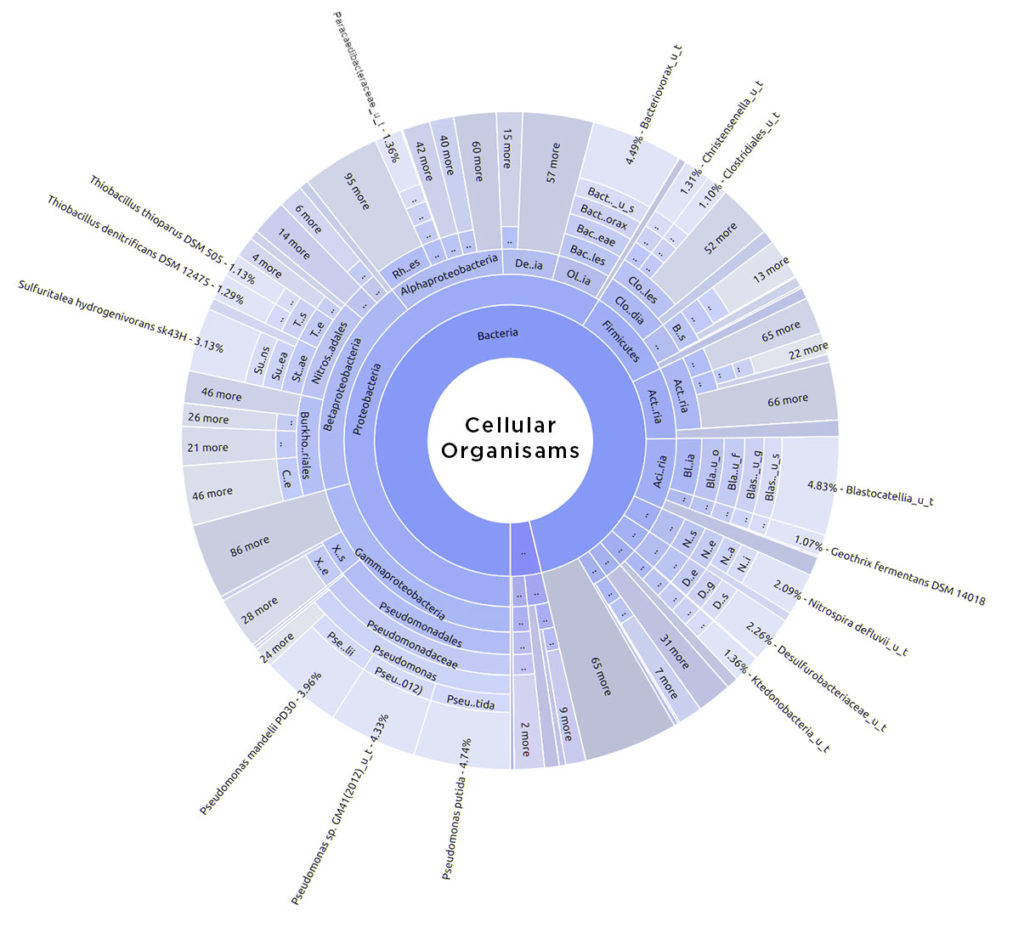
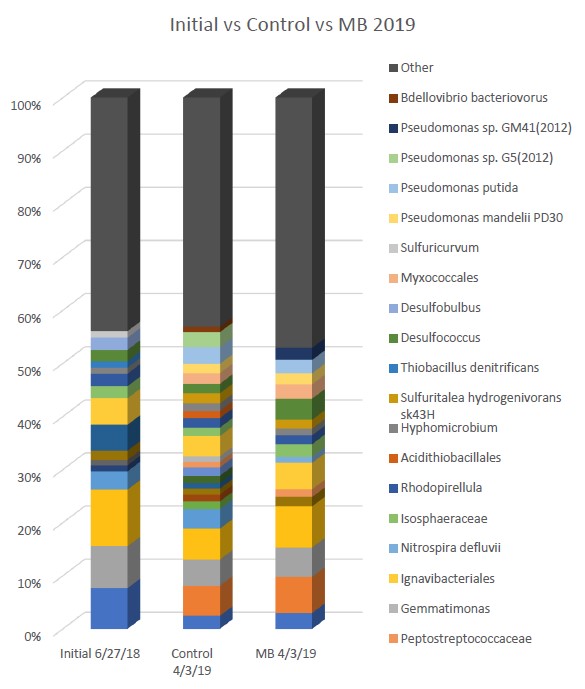
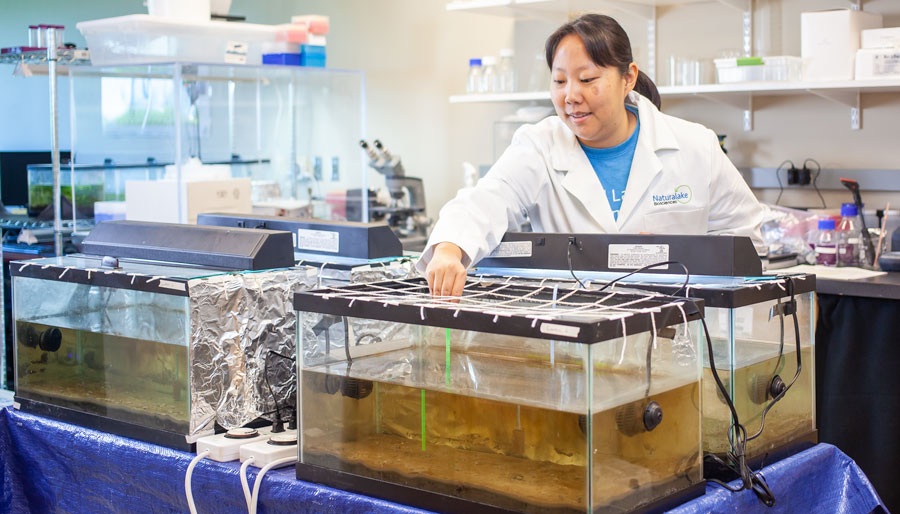
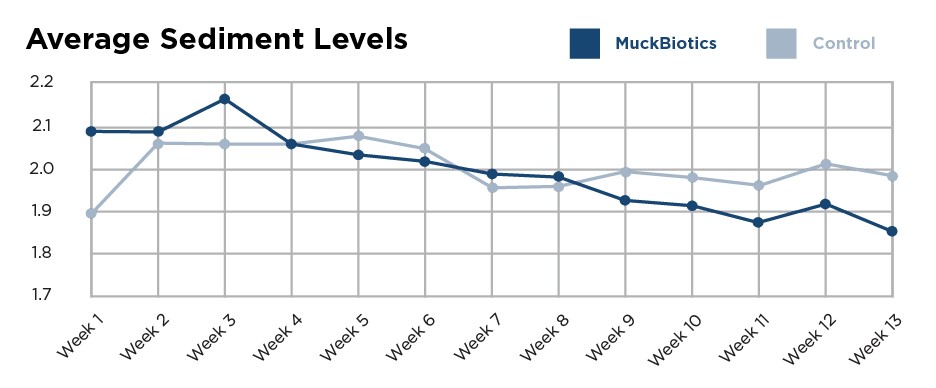
Specifications
Common Uses
- Lakes and ponds
- Aquaculture
- Shorelines
- Golf courses
- Retention ponds
- Decorative Ponds
- And more!
Benefits
- Removes buildup of organic matter.
- Improves water quality and clarity
- Restores balance to water bodies
- Reduces internal nutrient load
Available sizes
- 13.6 Kg Bags
| Ingredients | Bio-vitamins, probiotics, and select bacterial cultures |
| Description | Dry brown tablet |
| Odor | Earthy odor |
| Stability – Activity loss | <1% Loss in 6 months when stored as directed: at 24°C in a sealed container with low humidity. |
| Storage and Handling | Store in a cool, dry space between 10 - 27°C. |
Dosage
Once per month or as needed.
*Do not mix directly with algaecides or herbicides.
**If used in conjunction with algaecide or herbicide, apply after chemical treatment for best results.
| Surface Area (m²) | Targeted Muck Reduction | Muck Maintenance & Prevention | Degradation of Floating Debris |
| 1,000 | 2.3 – 5.7 kg | 1.1 – 2.8 kg | 0.57 – 1.7 kg |
| 2,000 | 4.5 – 11.3 kg | 2.3 – 5.7 kg | 1.1 – 3.4 kg |
| 4,000 | 9 – 23 kg | 4.5 – 11.3 kg | 2.3 – 6.8 kg |
| 20,000 | 45 – 113 kg | 9 – 57 kg | 9 – 34 kg |
| 40,000 | 91 – 227 kg | 45 – 113 kg | 23 – 68 kg |
| 400,000 | 907 – 2270 kg | 454 – 1130 kg | 227 – 680 kg |
Include in Treatment Programs for
- Filamentous Algae
- Planktonic Algae
- Cyanobacteria
- Muck & Sludge
- Water Clarity
- Nutrient Reduction
- Aquatic Plants
- Submerged Plants
- Unique Issues
Downloads
REGEN-Floc®
REGEN-Floc®
REGEN-Floc® is a complete water quality and clarity restoration tool. This advanced probiotic and flocculant combine scientific research in bioengineering, phosphorus binding, and coagulation/flocculation resulting in a product that will improve all aspects of water quality. REGEN-Floc® provides a natural way to stop lake eutrophication and restore your lake to a more pristine state.

Science Behind It
Eutrophication is when a lake receives excess nutrients (phosphorus and nitrogen) from the watershed and from deposited sediments, called internal nutrient loading. These excess nutrients lead to poor water clarity, algae blooms, low oxygen levels and an imbalanced ecosystem. Nutrients need to be maintained in lower amounts with good water clarity to promote a naturally balanced ecosystem where aquatic life thrives.
REGEN-Floc® completely reverses eutrophication by removing excess nutrients and turbidity. This one-of-a-kind proprietary formula of select bacterial cultures, flocculant, and phosphorus binders works in synergy to provide a complete restoration solution that permanently binds phosphorus in water and sediments, reduces nitrogen, and removes unwanted turbidity.
Description and Benefits
– Breaks down organics and binds phosphorus in the water column
– Improves water quality and clarity within hours
– Eliminates internal phosphorus re-cycling from the sediment
– Safe and easy liquid formulation with no irrigation restrictions
– Does not impact water pH or alkalinity
– Maintains desired turbidity, TSS, and Secchi
Dosage
MAXIMUM Dosage Rate by Volume
Metafloc Dosage – For water column nutrient & clarity | ||
| Mildly Eutrophic (30 – 50 µg/L Phosphorus 1.2 - 0.9 m. Secchi) | Eutrophic (50 – 100 µg/L Phosphorus 0.9 - 0.6 m. Secchi) | Eutrophic (50 – 100 µg/L Phosphorus < 0.6 m. Secchi) |
| 0.6 - 1.8 mL / m3 | 1.8 - 2.5 mL / m3 | > 3.6 mL / m3 |
For Sediment Nutrient Removal | ||
| Mildly Eutrophic (250 mg/kg sediment P) | Eutrophic (550 mg/kg sediment P) | Eutrophic (750 mg/kg sediment P) |
| 190 L per acre | 380 L per acre | 532 L per acre |

